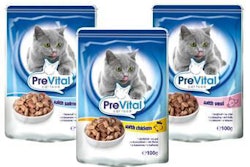As previously reported (see www.petfoodindustry.com/47831.html), recent amendments to the Association of American Feed Control Officials (AAFCO) Model Regulations for Pet Food and Specialty Pet Food will require calorie content statements on all dog and cat food labels within the next few years (the exact time frame for compliance is still to be determined).
There currently are two AAFCO-accepted methods upon which to determine and report metabolizable energy (ME). The first method is to conduct proximate analyses (crude protein, crude fat, crude fiber, moisture and ash) and insert the average results into the "modified Atwater" equation (the "calculation method"). The other method is to conduct a feeding trial to determine digestibility (with or without urine collection) and use the resulting values in a different equation to estimate ME (the "feeding trial method"). While the latter method is generally regarded to be more accurate, recent research has shown that the results derived from the former method may not be as aberrant as previously presumed.
Contrary to some speculation on the Internet, the modified Atwater equation was not developed by AAFCO as a means for the industry to purposefully underestimate calorie content and hence justify higher feeding amounts. Rather, it was proposed by a researcher in the 1980s as a better predictive fit for commercial petfoods compared to the standard Atwater equation that was used to estimate calorie content of human food products. In fact, the National Research Council (NRC) used this new equation in its 1985 publication Nutrient Requirements of Dogs.
It was known even at that time that it would tend to underestimate highly digestible foods but overestimate less digestible foods (e.g., a high-fiber dog food intended for weight loss). On average, though, it provides a better correlation with feeding trial results than the standard Atwater equation, which overestimates calorie content for a much larger range of petfoods than the modified version.
Still, a method of calculation from analytical results that more accurately predicts calorie content over a broad range of types and compositions of petfoods has long been desirable, and a number of equations have been proposed over the years. In its 2006 Nutrient Requirements of Dogs and Cats, NRC cites two equations (one for dog foods and one for cat foods) that reportedly do better jobs at predicting calorie content than the modified Atwater method. However, they are also more complicated and less intuitive than the modified Atwater equation, so it would be more difficult to teach non-nutritionists and people outside of the industry how to use the NRC equations to determine or confirm the calorie content of a petfood.
A recent study reported in an online scientific journal by Hall and others compared various predictive equations to results from 558 dog and cat feeding trials. It found that overall, the modified Atwater equation was highly correlated with the feeding trial results, especially for dog foods (average difference = 0.16%, or 5 kcal/kg off the actual ME from feeding trials). The average difference for cat foods was not quite as close, but still pretty good. In fact, in this study the modified Atwater values correlated as well as the 2006 NRC equations for both dog and cat foods (all r2 >0.97).
While these results are reassuring as to the relative accuracy of the current AAFCO calculation method, the authors propose new equations that are even more highly correlated with feeding trial results (r2 >0.99). They do require determination of gross energy by bomb calorimetry, though. Because this is an analysis that is usually not performed in the assessment of a petfood, a company would have to do a little extra work to use this method.
What should companies take from this? Even though on average the modified Atwater equation has been found to be a good predictor of calorie content, there will be products that skew from the norm, with the differences between the calculation method and the feeding trial method much greater. AAFCO provides the option of using either method (although when the new regulations are enforced the label must indicate the method as either "calculated" or "fed").
While for most cases the modified Atwater method might be perfectly suitable in providing for a reasonable calorie content statement, in those circumstances when a substantial deviation from actual ME is suspected the company cannot use the new Hall et al. equation in its stead. However, the company can use the new equation to determine if the discrepancy between the modified Atwater value and the likely feeding trial value is going to be significant enough to justify the conduct of a feeding trial.


















